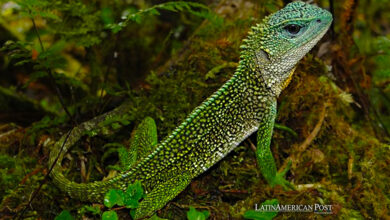Abandoned Pets in Cuba Face Crisis Amid Economic Struggles

As economic hardship and mass migration escalate in Cuba, the number of abandoned pets has surged. Animal activists on the island are stepping up and rescuing abandoned dogs and cats, but the crisis continues to grow, straining resources and shelters.
The Growing Crisis of Abandoned Pets
Pepa and Mami were among the fortunate few. These dogs, abandoned by their owners amid Cuba’s economic crisis, were rescued by animal rights activists. They were given food, sterilized, and eventually found new homes. Sadly, many other pets have not been as lucky. They are left to roam the streets as their owners flee the island or struggle to care for them.
Animal shelters in Havana are grappling with a significant increase in abandoned pets, primarily cats and dogs, as Cuba faces its worst economic downturn in decades. The surge in pet abandonment coincides with a massive wave of Cuban migration, with hundreds of thousands leaving the country. “We’d receive a phone call from someone asking us to care for their pets because they’re suddenly migrating and don’t know what to do with them,” said Elizabeth Meade, founder of Adoptions for Love, an animal shelter in Havana, in an interview with the Associated Press (AP).
This heartbreaking dilemma is unfolding as the economic crisis worsens, with many Cubans unable to afford the costs of caring for their pets or transporting them when they leave. Although Meade’s shelter has found homes for about 300 rescued pets in the past year, many were returned or went missing when their new owners also decided to migrate. “For these animals, it’s not always a happy ending,” Meade told AP.
Mass Migration and Its Impact on Pets
The migration crisis in Cuba has reached unprecedented levels. Between October 2021 and September 2024, U.S. authorities recorded more than 600,000 encounters with Cuban migrants. This number is staggering for an island with just over 10 million population. In addition to those heading to the United States, thousands more have migrated to Spain and other Latin American countries.
For many Cubans, taking their pets with them is not feasible. Transporting an animal from Havana to Miami can cost up to $1,200, which includes medical exams and the flight. Since September 2024, a new legal requirement has added $1,300 for quarantine procedures, making it even more difficult for pet owners to bring their furry companions. As a result, many are forced to leave their pets behind, unsure what will happen to them.
“Pet owners face an impossible choice. They can’t afford the cost of travel for their pets, and they don’t want to abandon them, but often they have no other options,” said Meade to AP. As more Cubans seek better opportunities abroad, the number of abandoned pets continues to rise, placing a tremendous strain on the animal shelters and rescue groups trying to care for them.
Economic Hardship Making Pet Ownership Unsustainable
For those who remain in Cuba, daily life has become a battle for survival. The country’s gross domestic product fell by 2% in 2023, and inflation has soared, making basic necessities, including food and fuel, increasingly scarce. For many Cubans, caring for a pet has become a luxury they cannot afford.
According to AP, while the average monthly salary for a state worker in Cuba is about $21, the cost of a 20-kilo bag of imported dog food can reach $70. A visit to the vet costs the equivalent of $10, which is prohibitive for many families. “Caring for pets has become economically unsustainable for most people,” said animal trainer Leandro Valdés to AP. Valdés is the proud owner of Koffee, a rescued dog who has gained viral fame in Havana, riding around the city in the back of Valdés’ motorcycle, complete with goggles and a seatbelt.
Animal activists like Valdés emphasize that pet abandonment is more than just an economic issue; it is also a matter of values. “The increase in migration has resulted in more pets being abandoned,” Valdés explained. There is a loss of values that comes with the deepening of the economic crisis. People struggle to survive, and sadly, pets are often the first to be neglected.”
Animal Activism: A Response to the Crisis
Despite the overwhelming challenges, animal rights activism has flourished in Cuba, with groups stepping up to rescue abandoned pets and push for stronger animal welfare laws. The movement gained significant momentum in 2018 when the widespread Internet and social media adoption allowed activists to coordinate efforts more effectively.
In 2021, activists celebrated a significant victory when the Cuban government passed a long-awaited animal welfare law. This legislation seeks to prevent animal cruelty and raise awareness about protecting animals. It also penalizes dogfights and the sacrifice of animals for religious rituals, both of which have been controversial issues in the country. However, animal advocates argue that the law is not enough to address the growing problem of pet abandonment.
“Abandonment is the worst form of animal abuse,” Valdés told the AP, highlighting the need for more vigorous enforcement of animal welfare laws. We need more than just laws; we need a change in mindset.” Valdés is a trainer and an activist, working alongside organizations to rescue pets like Koffee and give them a second chance.
Adoption shelters, like Meade’s Adoptions for Love, are at the forefront of this battle. Meade explained to AP that her shelter relies heavily on donations and volunteer work, as there is little government support for animal welfare initiatives. The shelter’s volunteers feed, sterilize, and care for the animals until they find a new home. However, the influx of abandoned pets has overwhelmed the shelters, making it challenging to keep up with the demand for care.
A Long Road Ahead for Cuba’s Abandoned Animals
Cuba’s economic struggles and mass migration have created a perfect storm for the country’s abandoned pets. While animal activists and shelters are doing everything they can to help, the scale of the crisis is daunting. Without more support—both from the government and the public—many pets will continue to be left behind, wandering the streets searching for food and shelter.
The story of Pepa and Mami may have a happy ending, but for too many animals, the future remains uncertain. As Meade told AP, “We do what we can, but the problem is much bigger than us. We need more people to step up and real change.”
The efforts of animal rights groups and individuals like Valdés offer hope, but the path to a sustainable solution for Cuba’s pets is long and fraught with challenges. In the meantime, the activists working tirelessly to rescue and care for these animals are providing a lifeline to those left behind by the crisis.
Also read: Argentina’s Economic Struggles Worsen as Poverty Rate Surges
For the pets who find their way to shelters like Adoptions for Love, there is at least the possibility of a second chance. And for Cuba’s animal activists, the fight continues—one dog, one cat, one rescue at a time.





